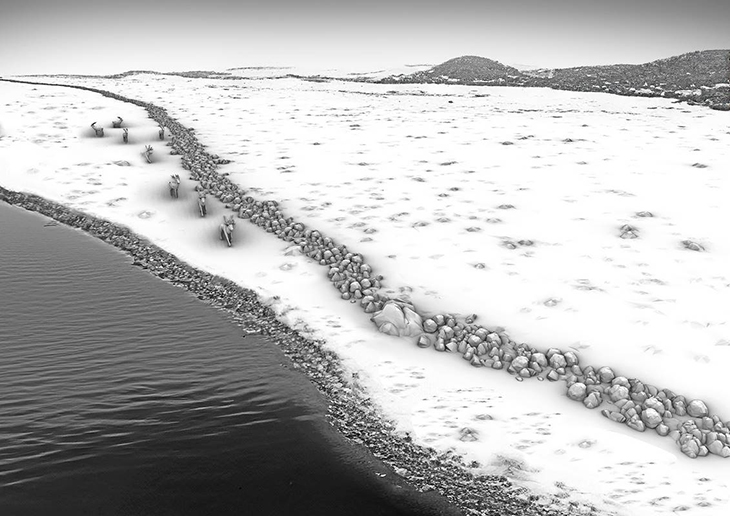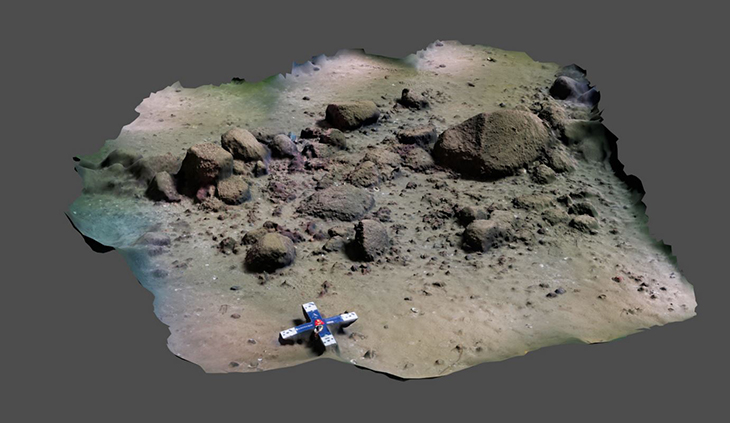
In the autumn of 2021, geologists made a remarkable discovery off the Baltic coast: an extraordinary row of stones, stretching over half a mile and lying just 21 meters below the sea’s surface.
The sheer regularity of the alignment – comprising approximately 1,500 stones – suggests a human origin rather than a natural formation. A diverse team of researchers now posits that Stone Age hunter-gatherers constructed this structure some 11,000 year ago, likely as a means to hunt reindeer.
This finding marks the first-ever identification of a Stone Age hunting structure in the Baltic Sea region, detailed in the Proceedings of the National Academy of Sciences (PNAS).
Originally, a team from Kiel University (CAU) set out to investigate manganese crusts on a seafloor ridge near the Pomeranian town of Rerik. However, their expedition took an unexpected turn when they stumbled upon this peculiar stone arrangement, featuring smaller stones interconnecting several large boulders.
Alerting the Mecklenburg-Vorpommern State Agency for Culture and Monument Preservation, they unveiled a significant archaeological find.
At present, the Baltic Sea’s depth at this site measures approximately 68 feet (21 meters). Consequently, the construction of the stone wall predates the substantial rise in sea levels following the conclusion of the last ice age approximately 8,5000 years ago.
As a result of this rise, vast expanses of previously accessible land became submerged, although prior to this event, the terminus of the wall likely bordered a bog or lake, evident from the basin-shaped depression observed underwater.
For German readers, an extensive study was conducted by a consortium comprising the Leibniz Institute for Baltic Sea Research Warnemünde (IOW), the research focal point at Kiel Marine Science (Kiel University), the University of Rostock, the Centre for Baltic and Scandinavian Archaeology (ZBSA, now part of the Leibniz Centre for Archaeology LEIZA), the German Aerospace Center (DLR), the Alfred Wegener Institute, Helmholtz Centre for Polar and Marine Research (AWI), and the LAKD M-V.
Utilizing modern geophysical techniques, the interdisciplinary team crafted a comprehensive 3D model of the wall and meticulously reconstructed the ancient landscape. By analyzing sediment samples extracted from the nearby southern basin, they managed to pinpoint the likely timeframe of the wall’s construction. Additionally, divers from the universities of Rostock and Kiel conducted thorough investigations of the stone wall.
Lead author of the study, Jacob Geersen, explains, “Our investigations indicate that a natural origin of the underwater stone wall as well as a construction in modern times, for instance in connection with submarine cable laying or stone harvesting, is not very likely. The methodical arrangement of the many small stones that connect the large, non-moveable boulders, speaks against this.”
Discounting natural processes and contemporary origins, the stone wall must have been erected post the last ice age cessation, during a period when the landscape remained unflooded by the Baltic Sea.

Marcel Bradtmöller from the University of Rostock, said, “At this time, the entire population across northern Europe was likely below 5,000 people. One of their main food sources were herds of reindeer, which migrated seasonally through the sparsely vegetated post-glacial landscape.”
“The wall was probably used to guide the reindeer into a bottleneck between the adjacent lakeshore and the wall, or even into the lake, where the Stone Age hunters could kill them more easily with their weapons.”
Mastering such techniques was crucial, given the immense skill and physical prowess required to effectively hurl a wooden spear at a sizable animal like a reindeer and successful inflict injury.
Similar prehistoric hunting structures have been unearthed in various regions worldwide, such as at the depths of 30 meters beneath Lake Huron in Michigan. In this location, American archaeologists uncovered stone walls and hunting blinds tailored for hunting caribou, the North American counterpart of reindeer.
Notably, these structures in Lake Huron and Rerik exhibit striking parallels, including their placement along the slope of a topographic ridge and their alignment with a lakeshore.
Given that reindeer herds vanished from our latitudes approximately 11,000 years ago due to warming climates and forest expansion, it is improbable that the stone wall postdates this ear. Consequently, it stands as the oldest human-made structure ever unearthed in the Baltic Sea region.
Jens Auer from the Mecklenburg-Vorpommern State Office for Culture and Monument Preservation (LAKD M-V), who was involved in the exploration and sampling of many of these sites, said, “Although numerous well-preserved archaeological sites from the Stone Age are known from the Bay of Wismar and along the coast of Mecklenburg-Vorpommern, these are located in much shallower water depths and mostly date to the Mesolithic and Neolithic periods (approx. 7,000 – 2,500 BCE).”
Further investigation of the stone wall and its adjacent seabed will be conducted utilizing advanced technologies such as side-scan sonar, sediment echo sounders, and multibeam echo sounders. In addition, upcoming diving expeditions led by research divers from the University of Rostock and archaeologists from the LAKD M-V aim to thoroughly explore the stone wall and its environs for potential archaeological artifacts that could provide insights into its purpose.
Luminescence dating, capable of determining the last exposure of a stone’s surface to sunlight, may offer a more precise estimation of the construction date of the stone wall. Moreover, the researchers plan to undertake a comprehensive reconstruction of the ancient landscape surrounding the site.
What are your thoughts? Please comment below and share this news!
True Activist / Report a typo


